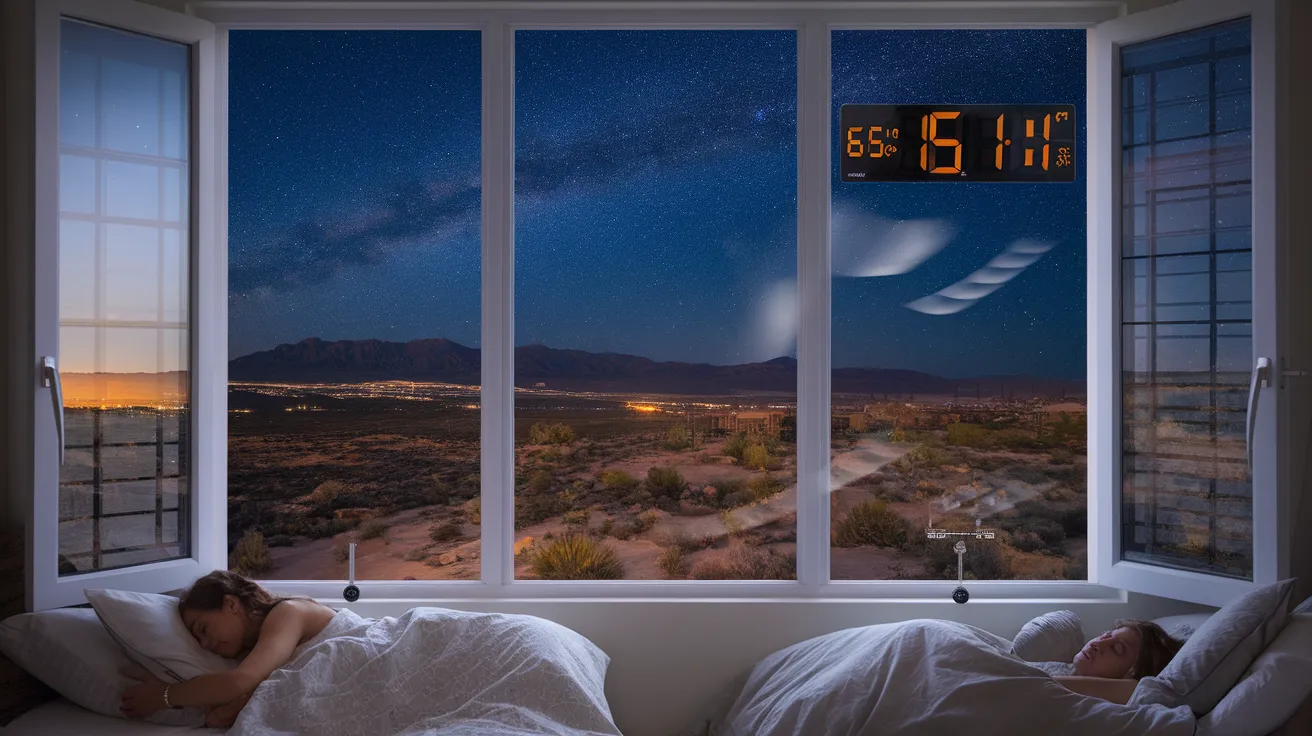Keeping cool in the Southern Utah heat can be both energy-efficient and cost-effective. Prioritize proper insulation, programmable thermostat use, and scheduled AC servicing. Take advantage of passive cooling, add window protection, and look into the benefits of high-efficiency ductless units. Remember the value of thoughtful outdoor planning, including carefully positioned trees and cooling ground surfaces, which can decrease thermal gain. Ready to explore the nitty-gritty of turning your residence into a warm-weather retreat without maxing out your AC and inflating your utility bills? Keep reading!

Essential Points
Grasping the Essentials of Energy-Smart Climate Control
Although many believe that maximizing the air conditioner is the single option to maintain a cool house during summer, understanding the basics of energy-efficient cooling offers a different view. It's not just about comfort, it's additionally about energy conservation. Know that cooling techniques like insulation, shading, and ventilation can substantially lower your energy usage. By ensuring good insulation, you're stopping cool air from seeping away, thereby minimizing the need to keep running your AC. Shading your windows, especially those in direct sunlight, can minimize heat buildup. And ventilation, whether mechanical or natural, helps move air around, keeping your home cool. A more energy-efficient home isn't just economical, it's environmentally-friendly too.
Picking the Ideal Air Conditioning Unit
Understanding energy-efficient cooling methods is an excellent starting point. However, choosing the right air conditioning system is key to optimize these strategies. The choice between central and ductless is a significant decision. Central air provides whole-house cooling, while ductless options cool selected spaces. Both systems offer unique benefits, but ductless systems can be more efficient if certain spaces see limited use. Review efficiency ratings when deciding on a unit. Higher ratings indicate better efficiency, but typically require larger initial investment. It's about finding the right balance, but investing in high-efficiency equipment pays off in the future. Note that proper equipment helps control that Southern Utah heat effectively.
The Role of Home Insulation in Regulating Home Temperature
Although it may not be the first thing you think about, proper insulation plays a crucial role in regulating indoor comfort during the warmest times of the year. Insulation materials work by providing thermal resistance, reducing the rate of heat transfer from your home's interior to the hot exterior. This indicates that the cooler air generated by your air conditioning system remains inside longer, easing the load on your AC unit and reducing costs on energy usage. It's essential to opt for insulation with a high R-value, which signifies greater thermal resistance. From fiberglass to spray foam, the appropriate insulation can make a substantial improvement in your home's warm-weather comfort and power consumption.
Maximizing the Power of Natural Ventilation
You can leverage natural ventilation to help keep your home at a pleasant temperature and decrease your energy bills. By understanding how it works, you can maximize the advantages of cross-ventilation throughout daylight hours. Additionally, using a nighttime ventilation strategy can deliver significant cooling advantages when temperatures fall.
A Guide to Natural Ventilation
Although it might appear complex, understanding natural ventilation is actually quite simple. The focus is on controlling the air movement in your home to maintain comfort while minimizing dependence on high-energy air conditioning. The secret is knowing when to open your windows and doors to welcome cooler air, and the right time to close them to prevent warm air from entering. You'll need to learn about multiple ventilation methods that can improve airflow, such as placing fans effectively and establishing routes for air to flow naturally. By harnessing the power of natural ventilation, you're not only maintaining a comfortable home, you're also promoting a more sustainable future.
Getting the Most from Cross-Ventilation
To properly leverage the effectiveness of natural ventilation, it's important to maximize the benefits of cross-ventilation. This necessitates strategic placement of windows and employing cross ventilation methods. When installing windows, choose those that face different directions. This provides a pathway for air to move easily across your home, providing natural temperature control.
What's more, you can enhance this process by utilizing adjacent windows. This encourages a cross breeze that can significantly decrease indoor temperatures. To make the most of the benefits, make certain that the windows are free from obstructions, both internal and external, such as furniture or shrubbery. By considering these elements, you're fully utilizing natural ventilation and reducing your dependence on energy-consuming cooling systems.
Night Ventilation Approach
While hot summer days may be sweltering, the nights typically deliver an invigorating coolness that you can utilize to your advantage. Here's where a nighttime ventilation approach proves useful. By leveraging the benefits of passive cooling, you can achieve effective nighttime cooling and increased air circulation.
Start by opening windows and doors when the outside temperature decreases below the inside temperature. This facilitates cool air to enter and force the warm air out, creating a natural air circulation. Then, as morning nears and the temperature starts increasing, secure everything up to retain the cool air inside. Using this simple yet effective strategy can make a substantial difference in keeping a cozy and energy-efficient home during the sweltering Southern Utah summers.
The Significance of AC System Maintenance
Many people don't know, but routine air conditioning service plays a pivotal role in avoiding AC breakdowns during those scorching summer months. Besides improving your AC's efficiency, but it's also key to extending the system's longevity. Here's why how this contributes to your home's energy efficiency.
Avoiding Infrastructure Capacity Issues
During hot summer days can drive your AC system to its limits, routine upkeep can help avoid system breakdowns. Think of your AC as a car. You wouldn't commence a cross-country drive without checking the oil, right? The same goes for your AC unit. Scheduled inspections can keep it running smoothly, reduce the risk of breakdowns, and contribute to energy efficiency.
Proactive measures include changing filters every month, coil maintenance, and ensuring proper refrigerant levels. Ignoring these essential procedures can lead to inefficiencies, forcing your air conditioning unit to use more power and increase energy usage. So, maintain your AC properly. Regular maintenance doesn't just helps prevent operational stress but additionally prolongs its lifespan.
Maximizing AC Performance
To guarantee your AC runs at peak performance, routine upkeep must be a main focus. Ignoring maintenance can cause lower effectiveness and escalating costs. Don't let that happen. AC optimization strategies include routinely maintaining filters, making sure your system isn't working harder than necessary.
Making improvements to your cooling system is valuable. A programmable thermostat lets you set more info custom cooling schedules, saving energy while you're away. You should also think about addressing duct leakage. Up to 30% of your air conditioning can be lost through duct leakage.
To maximize your AC's efficiency, it's essential to maintain regular maintenance and consider system enhancement options. The result will be a more comfortable house and more manageable bills during the summer months.
Increasing Equipment Longevity
Besides the instant perks of decreased energy usage and monetary benefits, consistent AC maintenance serves a crucial function in extending the durability of your equipment. Proper equipment maintenance isn't just about resolving issues as they emerge; it's about stopping them before they happen. By routinely maintaining and checking your AC system, you decrease component stress, enhance operation, and prolong its service life. View it as an investment in longevity. Keep in mind, a properly serviced AC unit doesn't just perform better it lasts longer. So, don't overlook regular maintenance. It'll keep your system running smoothly, reduce your costs in the long run, and help you handle the Southern Utah heat competently and reliably.
Smart Thermostats: Transform Your Energy Savings
When looking for an effective method to reduce energy consumption this summer, a smart thermostat can be the breakthrough you need. With the power to learn your schedule and optimize temperature control, it surpasses conventional thermostats. The advantages of a smart thermostat exceed simple convenience. When utilizing one, you're making an informed decision to enhance energy performance in your home, and this generates significant energy savings. You can also adjust from afar it through an app, offering even more flexibility. Basically, a smart thermostat offers comprehensive management of your home's energy use, helping you stay cool in the Southern Utah heat without high expenses.
Landscaping Guidelines to Improve Cooling and Energy Performance
Even though a smart thermostat serves as an effective means of controlling energy use in your home, another effective method can be found in smart landscaping. Strategically placing shade trees at the south and west sides of your home can reduce your air conditioning needs significantly. These leafy giants function as natural barriers against the sun's heat, supporting outdoor cooling.
You might want to include xeriscaping plants to your garden. These water-efficient species need minimal water, helping to preserve this valuable resource. Furthermore, their ability to flourish in warm conditions contributes to a more temperate setting.
In conclusion, stay away from dark and absorbent materials for outdoor paths. Select reflective surfaces as an alternative. They deflect the sun's rays, additionally lowering heat around your home and enhancing your energy efficiency.
Popular Questions
What's the Effect of Humidity on Efficient Air Conditioning in Southern Utah?
Moisture levels influence the energy efficiency of your cooling system. Humid air requires more energy to cool, leading to higher energy usage. For this reason, adding a dehumidifier can improve your AC's efficiency and help you save on energy expenses.
What Are Some Energy-Efficient Alternatives to Air Conditioning?
You can consider evaporative coolers and ceiling fans as power-saving solutions to traditional AC. These solutions work well, consume less power, and lower your environmental impact. It's an efficient, budget-friendly approach for maintaining comfort in Southern Utah.
Is Solar Power Effective for Cooling Solutions
Yes, you can use solar power for energy-efficient cooling. Solar cooling systems leverage solar panel capabilities to energize your cooling demands, making it a sustainable, economical option to conventional air conditioning.
How Does Nighttime Temperature Affect Energy Efficiency?
During cooler evening hours, it's an ideal time to boost energy efficiency. Let the cool night air in by opening windows, which helps reduce your AC usage. Note that strategically controlling overnight temperature drops efficiently addresses temperature fluctuations.
Tax Incentives for Installing Energy-Efficient Cooling Equipment
You can qualify for tax incentives when putting in energy-efficient cooling equipment. Look into local and federal programs for installation incentives. That's a smart approach to reduce expenses while reducing your carbon footprint and summer cooling bills.
Conclusion
You're ready to beat the Southern Utah heat this summer! Keep in mind, an energy-efficient cooling system isn't as elusive as finding a snowball in the desert. With an efficient AC, solid insulation, proper ventilation, routine maintenance, a programmable thermostat, and strategic landscaping, you can maintain a cool, comfortable home without excessive costs. You're not only saving energy, you're also taking a meaningful step towards sustainable living.
 Spencer Elden Then & Now!
Spencer Elden Then & Now! Tony Danza Then & Now!
Tony Danza Then & Now! Alisan Porter Then & Now!
Alisan Porter Then & Now! Joshua Jackson Then & Now!
Joshua Jackson Then & Now! Ryan Phillippe Then & Now!
Ryan Phillippe Then & Now!